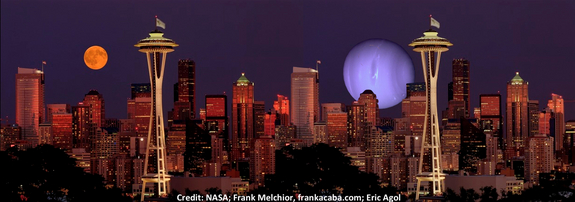We’ve talked a little bit about planetary migration and how it might happen. For some reason, a good chunk of distant solar systems feature hot Jupiter’s, large enough that they may have formed in the frost belt, orbiting crazy close to their primary star. Tidal deceleration, interaction and collision with other planets or smaller objects, detection bias? A new system worlds that could collide may offer clues:
(Wired Mag) — A rocky planet 1.5 times the size of Earth and a Neptune-like gas giant were spotted orbiting a star daringly close to each other.
The two-planet Kepler-36 system is the Kepler space telescope’s latest treasured find, reported today in the journal Science by researchers from the Harvard-Smithsonian Center for Astrophysics and the University of Washington. Passing less than five Earth-moon distances apart every 97 days, the planets are far closer together and more different in density than any two planets in our solar system.
Looking from the smaller planet’s surface (as depicted above), the gas giant would appear more than twice as big as the full Moon appears from Earth. The wrenching gravity between the planets would stretch and squeeze them, which might make the rocky one volcanic.
Kepler 36 is 1200 light years away toward the constellation Cygnus. The star is slightly larger and hotter than our sun and it’s estimated to be about 6 to 7 billion years old. The two planets orbit the star very close, around two weeks for their respective “years.”
It is extremely unlikely an ice giant formed well inside the equivalent orbit of Mercury or that this close arrangement between two planets would be stable for 6 billion years. Some thing is going on in this system and with these two planets that we do not understand. And if we figure it out, it could help explain how and why what should be frozen gas giants orbiting elegantly in the far, cold reaches seem to spiral in closer and faster to their star in so many exo solar system.



Fascinating exoplanetary find. Cheers!
The view from that rocky world -if you could live there to see it – might be something like theview of Neptune and Luan’s distance seen here :
http://www.youtube.com/watch?v=u1Yi58jtNdY
maybe? Or not. Who knows?
Ignorant layperson question: Why doesn’t a gas giant so close to its star simply evaporate?
Much better, but from the perspective of tthe rock planet does the sun (appear to) rise in the east?
@2. brucecoppola :
My understanding – possibly mistaken FWIW :
Having a lot of gravity and a lot of gas to lose is why.
Although I’m pretty sure we know of a number of Hot Jupiters that are evapourating away, others that are puffed up to unexpected sizes due to heat from without and within and perhaps some “SuperEarths” in what I like to call the Mustafar planet class (ie. lava worlds) could well be the solid remaining course of former gas giants in ultra-inner-Mercurian type uber-close orbits.
Bruce, without knowing any of the metrics, like free mean velocity and escape velocity vs heating and all the other important thigns … I’d say you’re aboslutely right. It would just probably take a long, long time.
If the spiraling process continues or even accelerates, and since we aren’t sure why it happens it makes sense that it might, I’d guess the giants plunge into their sun long before much of the gas is gone.
If that does happen from time to time … surely the change in brightness and possibly even the temporary spectral changes, would be observable. So maybe we’ll actually catch a sun in the act of cannibalism.
Thank you both. Yeah, on further thought I figured sheer size and gravity would make it take awhile. StevoR’s scenarios are fascinating. Good thing we live in a relatively quiet neighborhood of the universe!